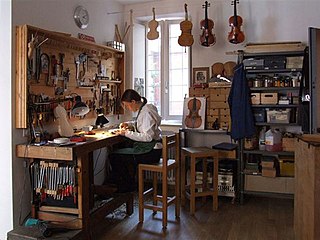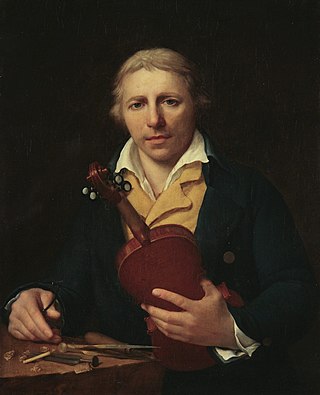
A luthier is a craftsperson who builds or repairs string instruments that have a neck and a sound box. The word "luthier" is originally French and comes from the French word for lute. The term was originally used for makers of lutes, but it came to be used in French for makers of most bowed and plucked stringed instruments such as members of the violin family and guitars. Luthiers, however, do not make harps or pianos; these require different skills and construction methods because their strings are secured to a frame.
Charles Collin-Mezin Jr. (1870–1934) was a French violin maker, and an Officier de l'Académie des Beaux-Arts.

Jean-Baptiste Vuillaume was a French luthier, businessman, inventor and winner of many awards. His workshop made over 3,000 instruments.

Mirecourt is a commune in the Vosges department in Grand Est in northeastern France. Mirecourt is known for lace-making and the manufacture of musical instruments, particularly those of the Violin family. Inhabitants are called Mirecurtiens.

Dominique Peccatte was a French luthier and above all a renowned bow maker. He was apprenticed in Mirecourt and later worked with Jean-Baptiste Vuillaume.
Joseph Alfred Lamy (père), was an important French archetier of the early twentieth century known as Lamy Père.
Nicolas Maline was a luthier and an archetier/bow maker.
Marc André Joseph Laberte son of Pierre Alexis Auguste Laberte, was trained as a luthier as well as a bow maker. As early as 1911, he began to play an active role in the Laberte-Humbert Frères company.

Nicolas Lupot was one of the most illustrious French luthiers of his time.
Victor François Fétique was a prominent French archetier (bowmaker) from a family of bowmakers.

The Bazin family is a highly esteemed family of bowmakers operating in Mirecourt, France from around 1840 throughout most of the 1900s.
Émile François Ouchard was a bow maker for stringed instruments / Archetier from Mirecourt, Vosges, France. Ouchard was also known as "Ouchard Père".
Émile Auguste Ouchard was a French bow maker of repute and son and pupil of Émile François Ouchard. Honors & awards include the Grand Prix of the 1942 International Paris Exhibition.
Louis Morizot (1874–1957) was an influential French bow maker of great reputation.
Nicolas François Vuillaume (1802–1876) was an important French luthier of the Vuillaume family, and younger brother of the illustrious Jean-Baptiste Vuillaume. He ran the leading workshop in Brussels, Belgium, and was appointed instrument maker to the Royal Conservatory in Brussels. His instruments won a number of medals at exhibitions.
Jacob Eury was a French luthier and bow maker. He was apprenticed in Mirecourt with his father as a violin maker, and later became an archetier / bow maker. According to the Paris census, he was noted having been in Paris as of 1792, where he certainly had some association with François Tourte. Throughout his life he moved many times and seems to have struggled financially. His work however never seems lacking. Top experts, agree that Eury's work is often compared to that of Tourte.
Charles François Gand (1787–1845) was one of the foremost violin makers/luthier and dealers of his time.
The Langonet Dynasty were a family of violin makers originating in Mirecourt, France, from around 1737 until the late 1900s.

Charles Mennégand was a French luthier and a repairer of violins, violas, and cellos. He is considered a superb 19th century French maker of cellos and is consistently counted among the handful of great French makers.

François Perrin; was a French violin maker who worked in Mirecourt. His work is characteristic of the Mirecourt school patterns of the time. Few of his violins survive but show good craftsmanship. Instruments that bear the stamp “François Perain” were also made by Perrin, as he used this alternate spelling in some of his violins and violas. His son Étienne Perrin succeeded him in the craft, and stamped his instruments "E. PERRIN FILS".








